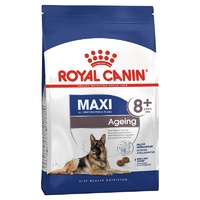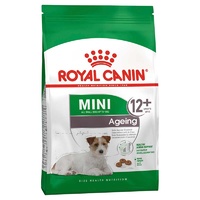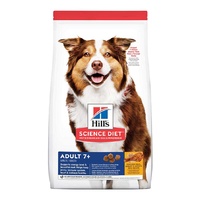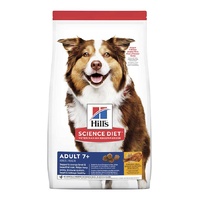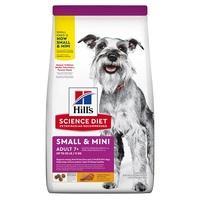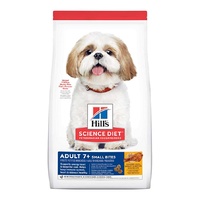Senior Science

The aim of feeding elderly, but otherwise healthy pets is to slow or prevent the progression of changes associated with ageing and to maintain a good quality of life.
Generally, dogs are considered senior once they have reached the final third of their anticipated lifespan. It is fair to say that large breed dogs age more quickly and their life spans are shorter than small breed dogs. For example, a six year old Great Dane may be considered senior, while a Maltese Terrier may be considered senior once it reaches 8-10 years of age. In Australia, 27% of dogs are aged 7-11 years and 11% are aged 12 plus years.2
Old age may unfortunately be accompanied by disease, such as chronic kidney failure, arthritis or heart disease, and dietary management is an important component of therapy. There is also a tendency towards obesity in older dogs and dental health is sometimes neglected. Good nutrition and regular veterinary attention can help prevent and manage these problems.
Older pets must be assessed as individuals and suitable diet plans established that meet their unique requirements.
In humans, ageing is associated with a gradual decline in energy needs which is around 20% less energy than the maintenance requirements of a young adult of the same weight. This decline in energy requirement appears to be due to reduced activity and a reduction in lean body tissue or muscle mass.
Similarly, ageing dogs exhibit an approximately 20% decline in maintenance energy requirements and a decrease in lean body mass which echoes that of ageing humans. There is no doubt that many older dogs sleep more, prefer short walks and are generally less active.
Although individual dogs may have increased energy requirements, it is clear that many senior dogs are at risk of obesity unless the energy provided by food is reduced according to their needs. Since it appears that older dogs digest food as well as younger dogs, calculation of their energy needs is relatively straight forward and should be based on requirements that are 20% less than those of the younger adult. However, physical activity helps to offset loss of lean body tissue and so the metabolic rate of older pets that remain very active may not reduce so significantly. Again, a reminder to assess each pet as an individual and determine their daily calorie needs accordingly.
Historically there has been a belief that reducing protein intake in older animals will relieve ‘stress’ on their kidneys and may help to prevent or slow progression of kidney disease. More recent research has shown that this theory cannot be supported. Whereas older dogs have a higher incidence of kidney disease than younger dogs, not all older pets will develop kidney failure.
The routine use of protein restricted diets in all senior dogs is therefore not necessary unless kidney function is impaired. Very low protein diets may actually be associated with a risk of protein malnutrition and poor palatability. In general, healthy older dogs should have diets based on their individual needs, which will be related to bodyweight, health status, condition and physical activity
Other Changes Associated with Ageing
Let’s consider some other changes associated with ageing in dogs.
With age, the skin begins to lose its elasticity. This change is often accompanied by hyperkeratosis, an abnormal thickening of the outer layer of the skin. Hairs may lose their pigment and become white due to a loss of pigment cells in the hair follicles. Alterations in the production of sebum can lead to dry, scaly skin and a duller coat. The prevalence of abnormal skin growths increases with age.
As we have seen, ageing in dogs is generally associated with a reduction in lean body tissue or muscle mass. Bone mass also tends to decline in older dogs, and changes are seen in the composition of the articular cartilage matrix. The cartilage becomes less resilient and has a reduced regenerative capacity. Osteoarthritis becomes more prevalent with advancing pet age.
Cellular damage from free radicals becomes even more pronounced with increasing age of the pet, and contributes to degenerative conditions associated with ageing. Research has shown that supplementation with the correct blend of dietary antioxidants can reduce the amount of this damage and so improve and maintain the quality of life.
Changes may occur in the cardiovascular system that place additional workload on the heart and in some cases, may lead to heart failure. Cardiac output may decrease by as much as 30% between midlife and the senior years. Older dogs may have reduced cardiovascular capacity during exercise such as decreased maximal heart rate and oxygen consumption.
Cognitive Dysfunction Syndrome (CDS) is a condition where pathological changes in the brain can lead to altered mental functioning. Symptoms include changes in awareness, loss of memory, deficits in behaviours learned from training early in life and reduced responsiveness to stimuli.
Oral health issues can lead to chronic pain, reduced food intake, tooth loss and systemic disease if not addressed properly in senior dogs
Nutrient Considerations For Senior Dogs
Senior dogs require the same nutrients they required in earlier life-stages, however the quantities of nutrients required and the way in which they are provided to the dog may differ. Factors to consider include the individual pet’s energy requirements as well as the presence and severity of degenerative disease.
As we have seen, a reduction in daily energy needs is generally seen in senior dogs. A decrease in muscle mass leads to a reduction in the body’s protein reserves that would normally be utilised during periods of stress or illness. Therefore, protein sources for older dogs should be highly digestible and of high protein quality. This helps to minimise losses of muscle mass. Dietary protein does not cause chronic renal disease in older pets, and should not be restricted in the diet of senior dogs simply because of old age.
To help reduce the overall energy density of the diet, a slight decrease in dietary fat may be beneficial. However, the type of fat provided in the diet should be highly digestible and rich in essential fatty acids.
An increase in dietary antioxidants such as vitamin E may also be beneficial to help combat oxidative stress and DNA damage which is thought to contribute to the ageing process.
As dogs age, they begin to experience memory loss and an altered temperament. Enhanced levels of dietary nutrients such as the omega 3 fatty acid DHA, vitamin E and the B vitamin choline may help improve cognitive function in senior dogs.
Nutrients to support joint health may be beneficial for older dogs such as chondroitin, glucosamine and stabilised Green lipped Mussel Powder.
Proper dental and oral health care is vital for senior dogs. Along with daily tooth brushing and veterinary inspection, diet may help promote dental health through kibble size and shape and the addition of active ingredients such as Sodium Tripolyphosphate (STPP) to help reduce tartar buildup.
Senior Dog Care
Good nutrition and regular veterinary attention can help slow or prevent the progression of changes associated with ageing and maintain a good quality of life for senior dogs.
The following are some practical tips to assist with care of the senior dog:
•Ensure regular veterinary check-ups take place, at least twice yearly
•Offer a diet that is based on the individual pet’s requirements
•For healthy senior dogs, choose an appropriate senior dog diet that contains highly digestible and high quality protein as well as other supportive nutrients
•Monitor body condition and regularly perform body condition assessments
•Feed to maintain an ideal body condition
•Provide regular exercise and play sessions at a level appropriate for the individual dog
•Ensure teeth and gums are inspected regularly and an oral health care plan is followed
•Always ensure free access to a supply of clean, fresh drinking water




